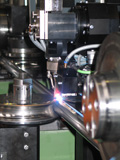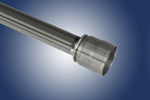27 August 2008
Rofin lasers in tube manufacture ? a well rounded process
 Steel tubes are today used to produce a vast array of products including water pipelines, steel furniture, machine frames and even fine tubes of less than 200µm in diameter are used within the medical device industry. The fact is that all around the world thousands of miles of pipelines, tubes and profiles are formed, welded, cut and marked every day.
Steel tubes are today used to produce a vast array of products including water pipelines, steel furniture, machine frames and even fine tubes of less than 200µm in diameter are used within the medical device industry. The fact is that all around the world thousands of miles of pipelines, tubes and profiles are formed, welded, cut and marked every day.
In many cases, the machines used for this diverse range of applications have lasers at the heart of the process, and with a complete range of laser sources and solutions available, Rofin are becoming involved in an increasing number of applications.
Laser welding – quick and reliable
The advantages of laser welding are well known to Esta Rohr, a manufacturing company in Siegen, Germany. Esta Rohr produce longitudinal seam welded, stainless steel pipes on a 3 shift operation using a 4.5 kW CO2 Slab laser integrated within a Rofin Profile Welding System (PWS).
“The benefits for us are obvious“, says Sven Pitzer, technical manager of Esta Rohr. “Compared to the traditional TIG-welding process, the laser is three times as fast. For example, we were welding tubes with dimensions of 18mm x 1 mm with the conventional TIG-machine at 5.5 m/min. By comparison the laser achieves 16 m/min, and it is not the power of the laser which restricts the speed, but the subsequent in line annealing unit”.
Another important factor for Esta Roht is the capability of the Profile Welding System to weld both austentitic and ferriitic stainless steels. In addition to the range of austenitic materials, ferritic steels such as 1,4509, 1,4520 or even 1,4521 are currently being used. These steels are often more economical but still offer a technical feasible alternative in many application areas due to their equal corrosion resistance. When manufacturing stainless steel tubes, the process benefits of the laser allow precise control of the laser parameters and therefore the energy used to create the weld, along the full length of the tube.
 Esta Rohr is not only convinced by the process benefits of laser welding. The laser also offers distinct advantages when it comes to system availability: The contact-free CO2 Slab laser system is head and shoulders above the traditional TIG-welding process, with its electrodes which have to be replaced regularly, causing the inevitable breaks in production and loss of valuable time on the machines. The laser by comparison, has an availability of almost 100 %.
Esta Rohr is not only convinced by the process benefits of laser welding. The laser also offers distinct advantages when it comes to system availability: The contact-free CO2 Slab laser system is head and shoulders above the traditional TIG-welding process, with its electrodes which have to be replaced regularly, causing the inevitable breaks in production and loss of valuable time on the machines. The laser by comparison, has an availability of almost 100 %.
In addition to Esta, more than twenty other companies worldwide have decided in favour of Rofin’s CO2 Slab lasers combined with the Profile Welding System for the manufacture of stainless steel tubes. With its integrated gap recognition the PWS sensor technology adjusts for even the smallest deviation of the weld seam position, and therefore optimum welding results are possible even under difficult conditions. The laser system does not only score on the speed of production, but also on the strength and durability of the welded seam. Laser weld seams are clearly more resilient than conventionally created weld seams which is a distinct advantage when tubes are to be formed and manipulated following the welding process.
Laser cutting - through thick and thin
The benefits of speed and precision are also apparent in the laser cutting and profiling of tubes. In instances where traditional methods such as drilling, milling, sawing or die cutting reach their limits, laser cutting opens up new possibilities.
All of the traditional methods of cutting and machining tubes generate mechanical loads which in turn can induce stresses into the materials and parts being processed. Laser cutting on the other hand is a contact free and highly flexible process. Simple programme changes enable different parts and profiles to be produced without the need to perform any tool changing operations. The thermal load on components which are cut using lasers is also minimal as demonstrated by Rofin’s StarCut Tube system, which is used to manufacture miniature and intricate components such as 200µm diameter medical Stents precisely and accurately in under 60 seconds.
The laser cutting process is not restricted to small and thin section parts. Large parts can be cut reliably and quickly by the laser, whether it is simple web cuts or very complex notch and contour cuts, the laser makes short work of the process. Thanks to the excellent quality of laser cut edges, there is often little or no further work required on the part, thus reducing component production times.
Quick to spot the benefits which could be obtained from lasers for processing of tubes and flat sheet, Alessandro Falconeri, founder and owner of the Italian company Dimensione Laser, has now been reaping the benefits of laser processing for more than ten years. The company now has a total of five tube cutting systems installed each of which uses a Rofin CO2 Slab laser. The systems are used to produce a large variety of different parts, many of which are low volume items. In this ever changing environment, the benefits of the laser are clear with simple programme changes, ultimate flexibility and high uptimes ensuring the maximum output from the available resources.
Falconeri is convinced of the benefits which he obtains from his Rofin lasers. The compact and low maintenance features of the Rofin Slab Lasers are not the only important factors for Falconeri. Equally important is the high uptime and minimal gas consumption. Besides these advantages, in Falconeris opinion, the key to success lies in the flexibility of the lasers which enables his company to produce a wide variety of different parts or component geometries both in low volumes and efficiently.
Laser marking – permanent and clear
The flexibility of the laser makes it the ideal solution to a wider range of marking applications on steel tubes. Tubes often require marking for quality control purposes and to enable part traceability. In these instances it is essential that the mark is permanent, clear and applied in the shortest time. Rofin has developed a concept which enables tubes to be marked “on the fly” and with this system integrated to the tube production line, the system can be used to mark - part numbers, production dates and times, bar codes, data-matrix codes and even ascending or descending serial numbers. The laser marking process is not affected by surface impurities such as the thin film of oil which may be present form the tube formin process.
Whether the task is welding, cutting or marking of the smallest micron-precision device, production of large tubes or the generation of complex contours, Rofin lasers are used by many companies as a reliable, flexible and efficient solution to the application.
Contact: Charles Sanders
E: sales@rofin-baasel.co.uk
- Contact Information
- Name: Charles Sanders
- Email: sales@rofin-baasel.co.uk

